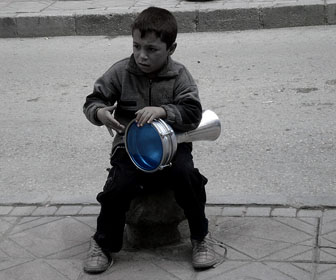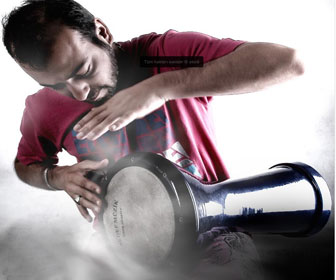 |
 |
| |
|
| |
DARBUKA | The Goblet Drum of Turkey.

|
| |
 |

|
|
| |
|
|
| |
Darbuka is commonly known as Goblet Drum because of its goblet shaped
body. The term Darbuka is taken from the Arabian word 'darba' (to
strike).
It is used extensively in middle east and is one of the most
significant Turkish traditional instruments. Generally these Goblet
Drums are build of metal, wood or clay. When played, the drumhead, which
remains attached with glue, produces a crispy sound. The bottom
remains open.
Darbuka is played with arms, resting it between the legs
of the player. The Goblet Drum produces three main sounds--'doum' or
the bass sound which is created by striking the drumhead near the
center, 'tek' or high-pitched sound which is created by striking the
edges of the drumhead, and 'pa' which is similar to muting technique
i.e not allowing the open sound of the drum by supressing the drum
sound with the player's hand resting on the center of the drumhead
rapidly after playing a stroke.
In Turkey, it is often played with the
help of a stick called 'cubuk'.
Darbuka is widely used in belly
dancing. In Turkey it is considered to be the main ingredient
instrument that is played in a belly dance. Its lighter weight makes
it more significant. In Turkey,the head-skin of Darbuka is mainly
built with fish or goat skin.
The drum is 18" high, and its head is
10" in diameter. It is considered as an important folk instrument in
the Middle East.
Today, it has also found its place in the field of
western classical music as well. Some Darbukas comes with a strap
which helps the player to hung it on his shoulder while playing or
else if he wishes to dance alongside playing.
Darbuka or the Goblet
Drum is considered as an essential ingredient in every festive
ocassions in Turkey as well as middle east.
You can watch demo videos by clicking the links below.
|
|
| |
|
|
| |
|
|
| |
Other Turkish Instruments:
Baglama
 Classic Kemence
Classic Kemence
 Karadeniz Kemence
Karadeniz Kemence
 Tar
Tar
 Kanun
Kanun
 Darbuka
Darbuka
 Tambur
Tambur
 Ud
Ud
 Zurna
Zurna
 Ney
Ney
 Tulum
Tulum
|
|
| |
|
|
|
<-Back
|
|
 |
|
